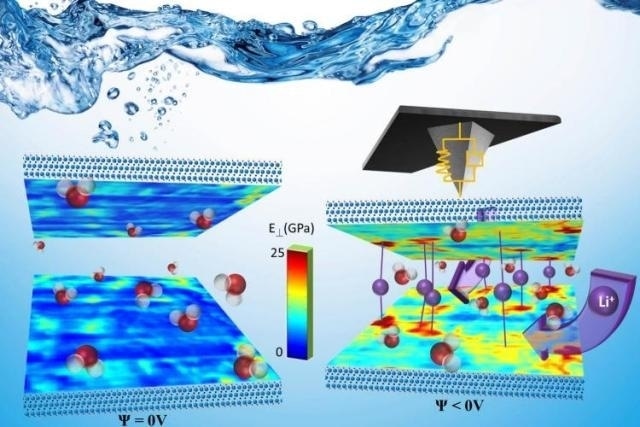Mar 17 2016
Scientists have successfully integrated hypothetical calculations and sophisticated in-situ microscopy to reveal critical clues about the properties of an advanced energy storage material for use in batteries and supercapacitors. The study was conducted by researchers from Oak Ridge National Laboratory (ORNL) of the Department of Energy (DOE).
 When a negative bias is applied to a two-dimensional MXene electrode, Li+ ions from the electrolyte migrate in the material via specific channels to the reaction sites, where the electron transfer occurs. Scanning probe microscopy at Oak Ridge National Laboratory has provided the first nanoscale, liquid environment analysis of this energy storage material. (credit:ORNL)
When a negative bias is applied to a two-dimensional MXene electrode, Li+ ions from the electrolyte migrate in the material via specific channels to the reaction sites, where the electron transfer occurs. Scanning probe microscopy at Oak Ridge National Laboratory has provided the first nanoscale, liquid environment analysis of this energy storage material. (credit:ORNL)
Fluid Interface Reactions, Structures and Transport (FIRST) research team at ORNL discovered how ions migrate and diffuse between 2D electrode layers during electrochemical cycling, in a liquid environment and at the nanoscale. This experiment was carried out by scanning probe microscopy that was accessed via the Center for Nanophase Materials Sciences (CNMS) user program. This movement and diffusion of ions is important to get a better understanding of how energy is stored in a material known as MXene, and what powers its excellent energy storage characteristics.
We have developed a technique for liquid environments that allows us to track how ions enter the interlayer spaces. There is very little information on how this actually happens. The energy storage properties have been characterized on a microscopic scale, but no one knows what happens in the active material on the nanoscale in terms of ion insertion and how this affects stresses and strains in the material.
Nina Balke, FIRST Center, DOE Office of Science Energy Frontier Research Center
The MXene material functions as a 2D electrode, and could be developed with the flexibility of a paper sheet. This material is built on MAX-phase ceramics, which researchers have been studying for many years. When the “A” layer is chemically removed, it leaves 2D flakes containing transition metal layers (the “M”), packing nitrogen or carbon layers (the “X”) in the ensuing MXene. This so-called MXene material looks similar to graphite.
These MXenes are capable of storing electrical charge, or a relatively high capacitance. It was only recently that these materials were studied as a medium to store energy for next-generation batteries.
The interaction and charge transfer of the ion and the MXene layers is very important for its performance as an energy storage medium. The adsorption processes drive interesting phenomena that govern the mechanisms we observed through scanning probe microscopy.
Jeremy Come, FIRST researcher
The ORNL research team studied the migration of ions inside the material, their movement after entering the material, and the way they interact with the material. One observation was if positively charged cations are introduced into the MXene material, which is negatively charged, the active material contracts and becomes stiffer. This discovery provided the basis for nanoscale characterization based on scanning probe microscopy. The local changes were calculated in stiffness when ions traversed the material. The team observed a direct correlation between the material’s stiffness and the ions’ diffusion pattern. Come also observed that the ions are integrated into the electrode material of a solution.
Therefore, we need to work in liquid environment to drive the ions within the MXene material. Then we can measure the mechanical properties in-situ at different stages of charge storage, which gives us direct insight about where the ions are stored.
Jeremy Come, FIRST researcher
This method had not been performed in a liquid environment until this study. In fact, until the studies conducted by the CNMS scanning probe microscopy group, the processes behind the insertion of ions and their corresponding interactions in the electrode had been not viable at the nanoscale.
These experiments emphasize the necessity for in-situ analysis to gain a better insight into the nanoscale elastic changes seen in the 2D material in wet and dry environments, and also to understand how ion storage impacts the energy storage medium (material) over a period of time.
The team is now planning to enhance the ionic diffusion mechanisms in the material, and will analyze different types of materials from the MXene range. The ultimate aim is to understand the basic mechanism as well as the mechanical characteristics of the process. This would not only aid in adjusting the energy storage, but would help to enhance the performance and lifespan of the material.
FIRST research team at ORNL provided further simulations and calculations built on density functional theory, which supports the experimental results. The study has been reported in the Advanced Energy Materials Journal.
Other researchers who took part in the study were Stephen Jesse, Michael Naguib, Sergei V. Kalinin, Yu Xie, and Paul R.C. Kent, all from ORNL.
The National Energy Research Scientific Computing Center and the Center for Nanophase Materials Sciences are DOE Office of Science User Facilities. The FIRST Center is an Energy Frontier Research Center and supported by the DOE Office of Science (Basic Energy Sciences).